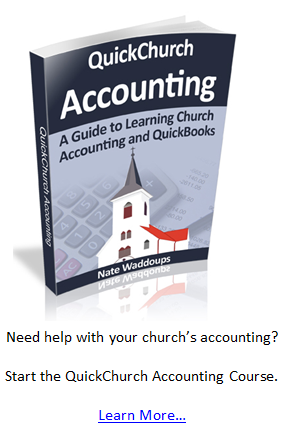We here are the Church Accounting Software Guide are teaming up with Icon Systems again in order to bring you a special series of posts about donations, tax laws, and year-end contribution reports. A special thanks goes out to Karla, the CPA and mastermind behind these posts.
Part 1
With the Holiday season and year end rapidly approaching, it might be a good time to review the reporting requirements for churches who receive contributions.
General Requirements:
As tax exempt organizations, churches are qualified by the Internal Revenue Service (IRS) to receive contributions from donors. Since qualified churches are not subject to federal income tax, these donations are tax-free to the church. Donors, in turn, may be able to deduct their contributions to churches on their income tax return. In order to take advantage of these special tax situations, the IRS has developed rules that apply to donors and to churches regarding contributions. These general rules are as follows:
- In order to claim a federal income tax deduction, the donor must have either a bank record or a written communication from the church.
- The donor is responsible for obtaining a written acknowledgment from the church for any single cash contribution of $250 or more.
- The church is required to provide a written disclosure to a donor who makes a payment in excess of $75 and the payment is partly for a donation and partly for goods and services received.
Lets take a detailed look at these three general rules and then move on to specific situations that churches may face.
The donor must have either a bank record or a written communication from the church :
For cash, check, or other monetary donations made after January 1, 2007, the IRS requires that the donor have either a bank record (i.e. cancelled check) or a written communication (i.e a receipt or letter) from the church in order to claim an income tax deduction. This requirement places the responsibility of obtaining the necessary documents on the donor. Although the church will not incur a penalty if they do not provide this information, the donor may not be able to deduct the donation on their income tax return without it. This may affect future contributions that the donor wished to make. Since most churches rely on the generous donations of their members, it may benefit them to assist the donors in this process. The written church communication to the donor should include the following:
- the name of the church
- the date of the donation
- the amount of any cash contributions
The donor must receive a written acknowledgment from the church for any single cash or non-cash contribution of $250 or more:
The donor cannot claim an income tax deduction for any single contribution of $250 or more unless the donor receives a written acknowledgment from the church. The church can either provide separate acknowledgments for each single contribution of $250 or more or one acknowledgment for several donations of $250 or more. The total yearly contributions are not added together to arrive at the $250 threshold. For example a written acknowledgment would not be required for a donor who donates $10 per week for 52 weeks (total of $520) even though the total is more than $250. If the donor made only two contributions of $260 each, then they would need a written acknowledgment. As mentioned in the first rule above, the church would not incur a penalty for neglecting to furnish the proper receipt, but churches who value their donors may wish to provide it. If the donor claimed an income tax deduction for the contribution and did not receive the proper receipt, the IRS could disallow his contribution on his income tax return. Again, this could affect any future contributions that the donor wished to make. This written acknowledgment should include the following:
- the name of the church,
- the date of the donation,
- the amount of any cash contributions,
- a description (but not the value) of non-cash contributions.
- In addition to the above, the written communication must contain one of the following statements:
-
- “No goods or services were provided by the church in return for the contribution.”
-
- “Goods or services that the church provided in return for the contribution consisted entirely of intangible religious benefits.” Or
-
- A description and good faith estimate of the value of goods or services other than intangible religious benefits that the church provided in return for the contribution.
The church is required to provide a written disclosure to a donor who makes a payment in excess of $75 and the payment is partly a donation and partly for goods and services received.
Sometimes churches host charitable events where the public needs to purchase a ticket to attend. Donors can only take an income tax deduction for the portion of the payment that is in excess of the fair market value of the goods or services received. For example if a church charges $100 for a “Fall Festival” which includes a meal valued at $30, the donor can only take a charitable deduction for the portion that exceeds the fair market value of the meal. In this example, the charitable donation would be $70. Even though the charitable portion is under the $75 threshold, a written acknowledgment is required because the total payment was in excess of $75.
In addition to the name of the church, the date of the donation, and the amount of the payment, the written disclosure should include:
- A statement that “ The amount of the contribution that is deductible for federal income tax purposes is limited to the excess of money (and the fair market value of any property other than money) contributed by the donor over the value of goods or services provided by the church.” AND
- Provide the donor with a good faith estimate of the value of the goods or services received by the donor.
The IRS calls the above mentioned donations quid pro quo. Further details about them can be found in the IRS code section 6115. The IRS can also impose a penalty to churches who do not follow the above rules. These penalty amounts can be found in IRS code section 6714. Section 6714 states as follows:
-
- (a) Imposition of penalty - If an organization fails to meet the disclosure requirement of Section 6115 with respect to a quid pro quo contribution, such organization shall pay a penalty of $10 for each contribution in respect of which the organization fails to make the required disclosure, except that the total penalty imposed by this subsection with respect to a particular fundraising event or mailing shall not exceed $5,000.
- (b) Reasonable cause exception - No penalty shall be imposed under this section with respect to any failure if it is shown that such failure is due to reasonable cause.
In plain English, this means that churches could be penalized $10 for each quid pro donation that was not properly disclosed with a penalty cap of $5,000 for each fundraising event. Proper disclosure means that it follows the rules mentioned above. Additionally, the IRS can impose a penalty to the church of $1,000 per person per year for aiding and abetting an understatement of tax under IRS code section 6701. This means that “the church knows or has reason to believe that members will rely upon the contribution statements the church provides in connection with reporting their tax liability and that the reliance on those statements will result in an understatement of tax.” Serious stuff indeed!
The IRS does allow some exceptions to the above rule. If an exception is met, the church does not need to provide the fair market value of the goods or services received by the donor on the contribution receipt or statement. These exceptions are as follows:
- Token Exception
- Membership Benefits Exception
- Intangible Religious Benefits Exception
Lets take a look at the three different types of exceptions listed above.
Token Exception:
- Insubstantial goods or services a church provides in exchange for a contribution do not have to be described or valued in the acknowledgment.
- Goods and services are deemed insubstantial if the payment occurs in the context of a fund-raising campaign in which the church informs the donor of the amount of the contribution that is a deductible contribution and:
- the fair market value of the benefits received does not exceed the lesser of 2% of the payment or $96, or
- the payment is at least $48, the only items provided bear the organization’s name or logo (i.e., calendars, mugs, or posters), and the cost of these items is within the limit for “low-cost articles”, which is $9.60.
- Free, unordered low-cost articles are also considered insubstantial.
The insubstantial goods or services dollar amounts listed above are for 2010. Guideline amounts are adjusted for inflation. Contact IRS Exempt Organizations Customer Account Services at (877) 829-5500 for annual adjustment information.
Membership Benefits Exception:
- An annual membership is considered insubstantial if it is provided in exchange for an annual payment of $75 or less and consists of annual recurring rights or privileges, such as:
- free or discounted admissions to the church’s facilities or events
- discounts on purchases from the church’s gift shop or library
- free or discounted parking
- free or discounted admission to member-only events sponsored by an organization, where a per person cost is within the “low-cost articles” limits.
Intangible Religious Benefits Exception:
- Benefits provided by the church that are not usually sold in commercial transactions
- Examples include wine served in a religious ceremony, admission to a religious ceremony, and receipt of a church newsletter.
- Benefits that are not intangible religious benefits include tuition for education leading to a recognized degree, travel services, and consumer goods.
Please refer to the “Charitable Contributions - Substantiation and Disclosure Rules” portion of the IRS publication “Tax Guide for Churches and Religious Organizations” or the IRS publication “Charitable Contributions - Substantiation and Disclosure Requirements” for more information. As always, please consult your CPA because you may have tax situations that are unique. Additionally, IRS rules are subject to change.
Icon Systems’ IconCMO addresses all of the unique situations above for churches and we look forward to working with your organization.


Hi Nate ++
I have a couple of Questions: 1. A member Donated the cost of Advertizing the Church in two different Papers (1 @ $975.62) & (1 @ $397.00), both paid w/CC, no monies passed through the Church. #2 A member Couple transfered $612.00 from their personal Savings Acct directly into the Church Bldg. Mortage Acct. (as a principal only payment) in the same Bank. Again No monies went through the Church. How do I cover the Church from the IRS, record the Donations so as to properly account for the $612.00 drop in the Mortg. Prin. Year End & Members Donations Statements??? Any Help Welcome.
Do you have a review on Shepard’s Staff accounting software? We are shopping around for a software for our small church and would like to be well informed.
I have entered all of our household members and contributions into your system. DO you have a pre-defined form or report that I can run to generate the year-end statements for each donor?